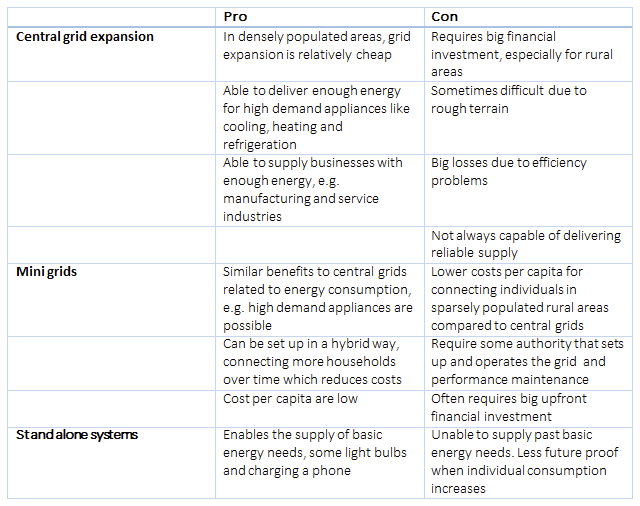2.2.3 Reading activity case
Course subject(s)
Module 2. Access
These readings materials are in addition to the clip of the interview with Yvo Hunink. This interview showed the complexity of providing energy access in rural India. The study materials below will provide some background on the various options currently being used to provide electricity access around the world.
Roughly, historically electrification problems can be divided in three categories:
- Electrification by expanding the central grid
- Setting up mini-grids
- Install stand-alone systems
See the table below for an overview of some of the pros and cons for the three alternatives.

This section gives some background in community-sharing projects as discussed by Yvo Hunink in the case interview.
For the case, we have discussed electrification in rural India. Historically, NGO’s and governments have tried to fulfill the demand for electrification in different kind of ways. In this case four infrastructures are presented: individual solar house systems and microgrids are showed in figure 1. The other two are explained below. Microgrids allow for various sources (e.g. solar, wind or diesel) to produce and distribute electricity locally. Individual solar systems consist of a solar panel, a few lamps, battery box and a charge controller. The Individual Solar House (ISH) setup is very common in remote places in rural India.

Source: Rhythima Shinde (2018) Institutional innovation – solar electrification sustenance. All rights reserved.
As you can see in figure 1, current attempts of electrification through ISH systems and micro grids do not lead to 100% access to electricity. In communities with solar systems, often a few houses do not have a solar rooftop installed whereas in micro grid projects, often the remote houses stay unconnected. Therefore, in the previous videos community-sharing projects were proposed, which allow local producers to share their energy with consumers. There are two types of sharing projects, (1) electricity can be shared with a grid structure between the houses in a community or by (2) using batteries as a physical way of sharing energy between local residents. In both cases, it is important to note that the energy is produced locally.

Source: Rhythima Shinde (2018) Institutional innovation – solar electrification sustenance. All rights reserved.

Inclusive Energy Systems: Exploring Sustainable Energy for All by TU Delft OpenCourseWare is licensed under a Creative Commons Attribution-NonCommercial-ShareAlike 4.0 International License.
Based on a work at https://online-learning.tudelft.nl/courses/inclusive-energy-systems-exploring-sustainable-energy-for-all///.



